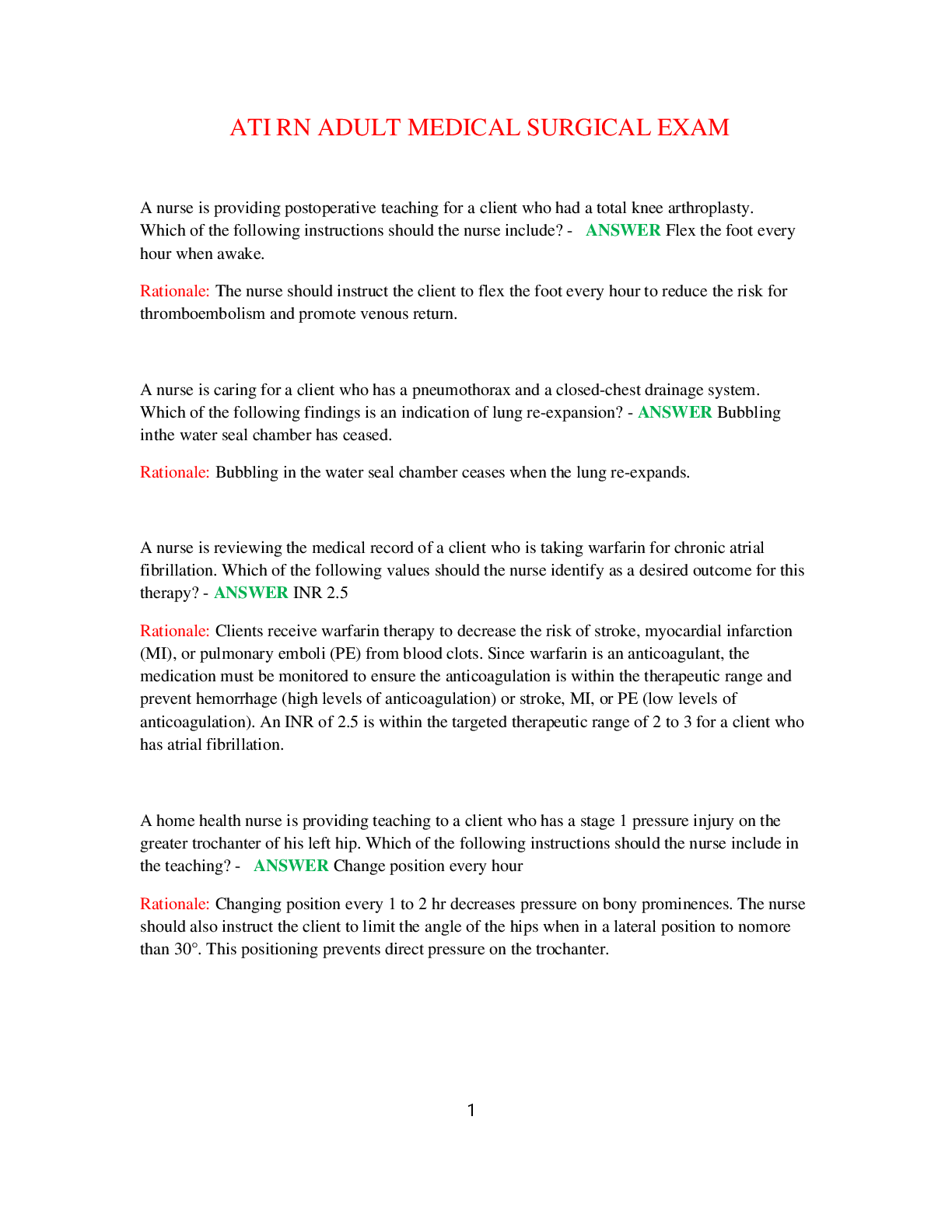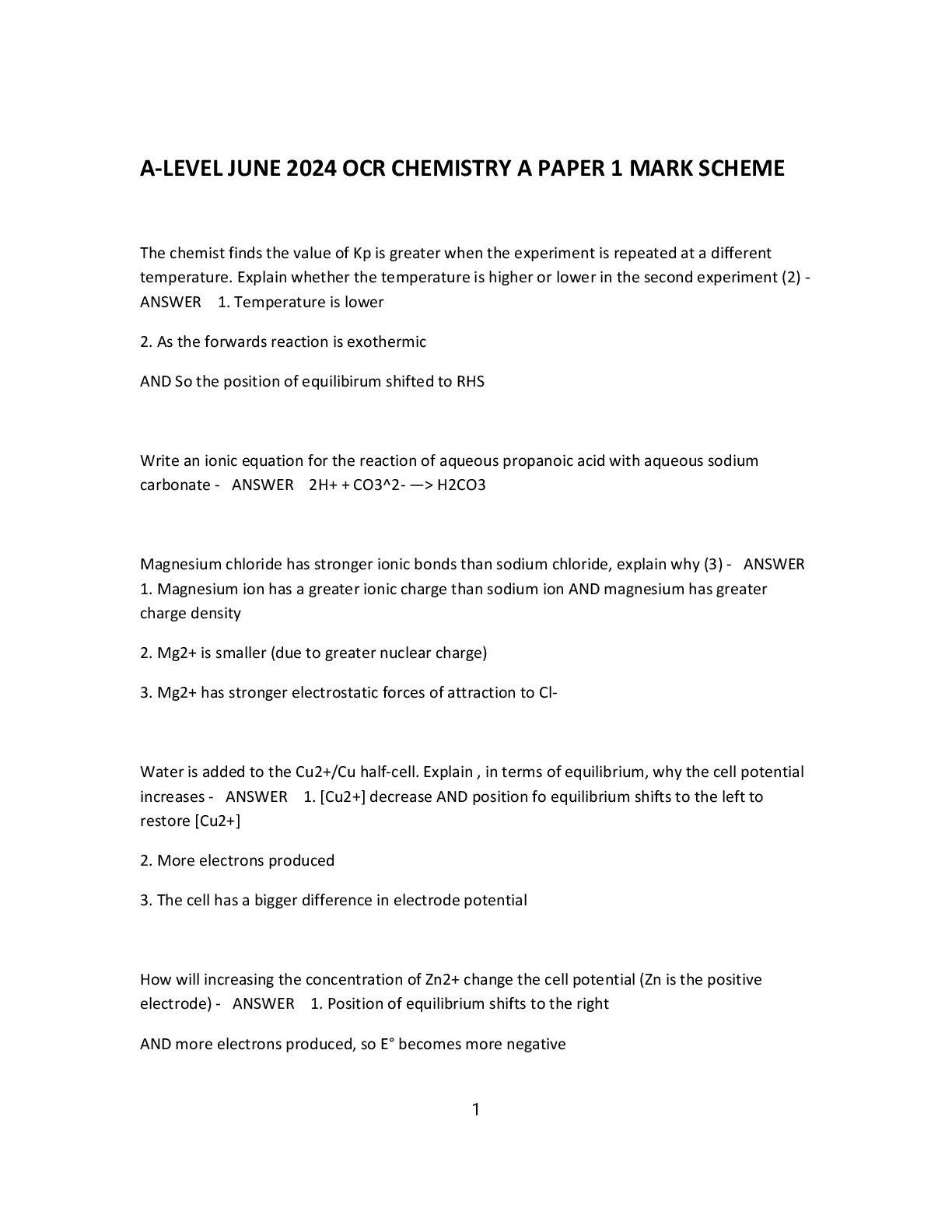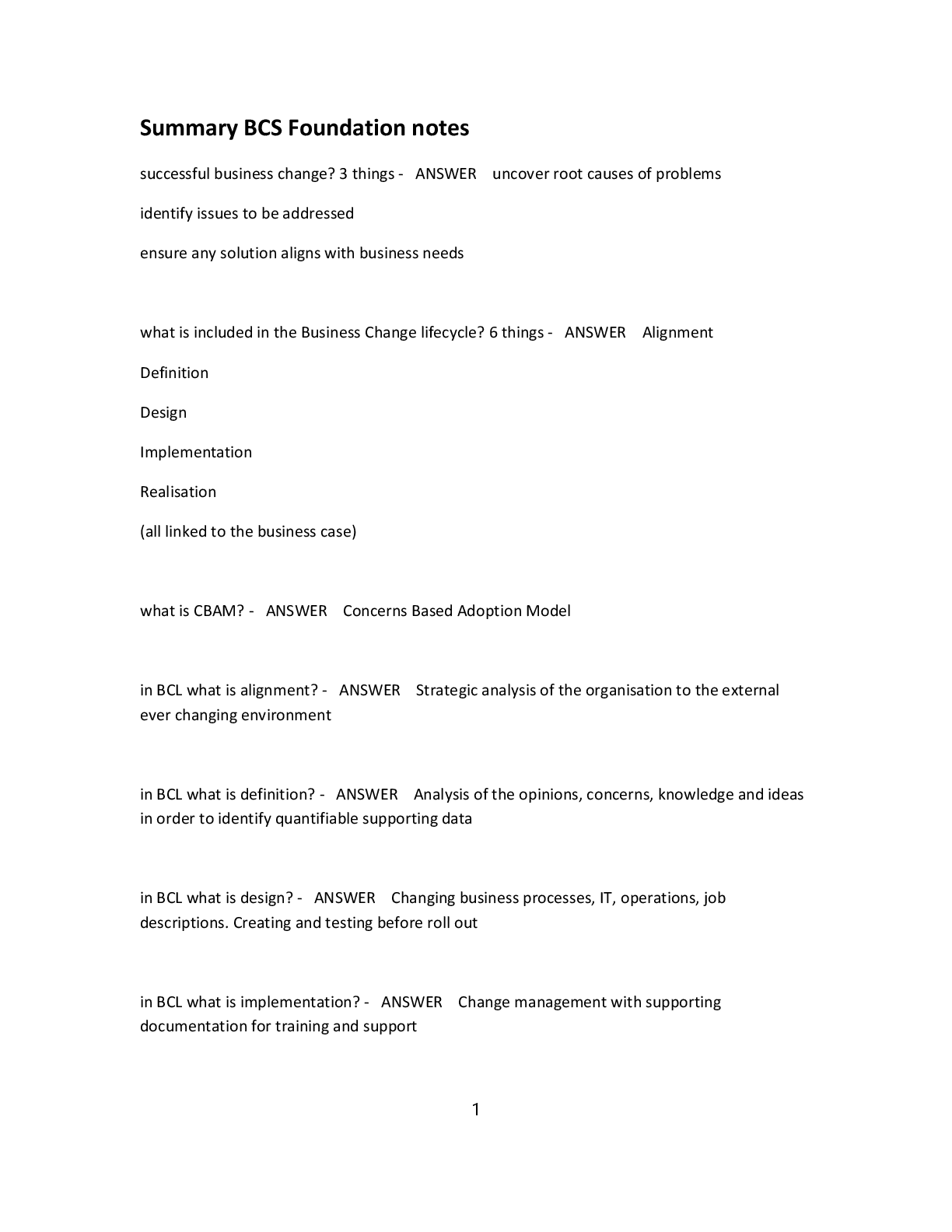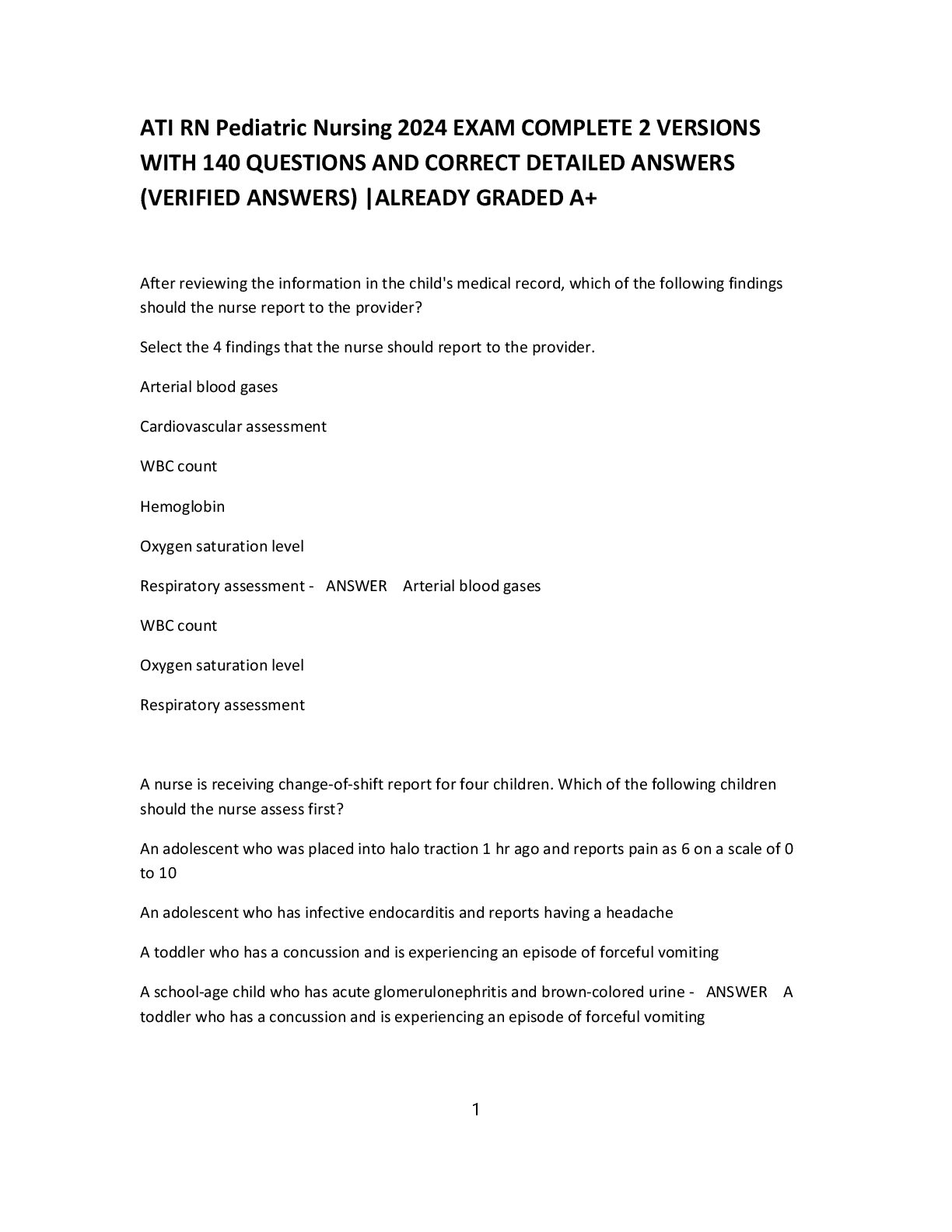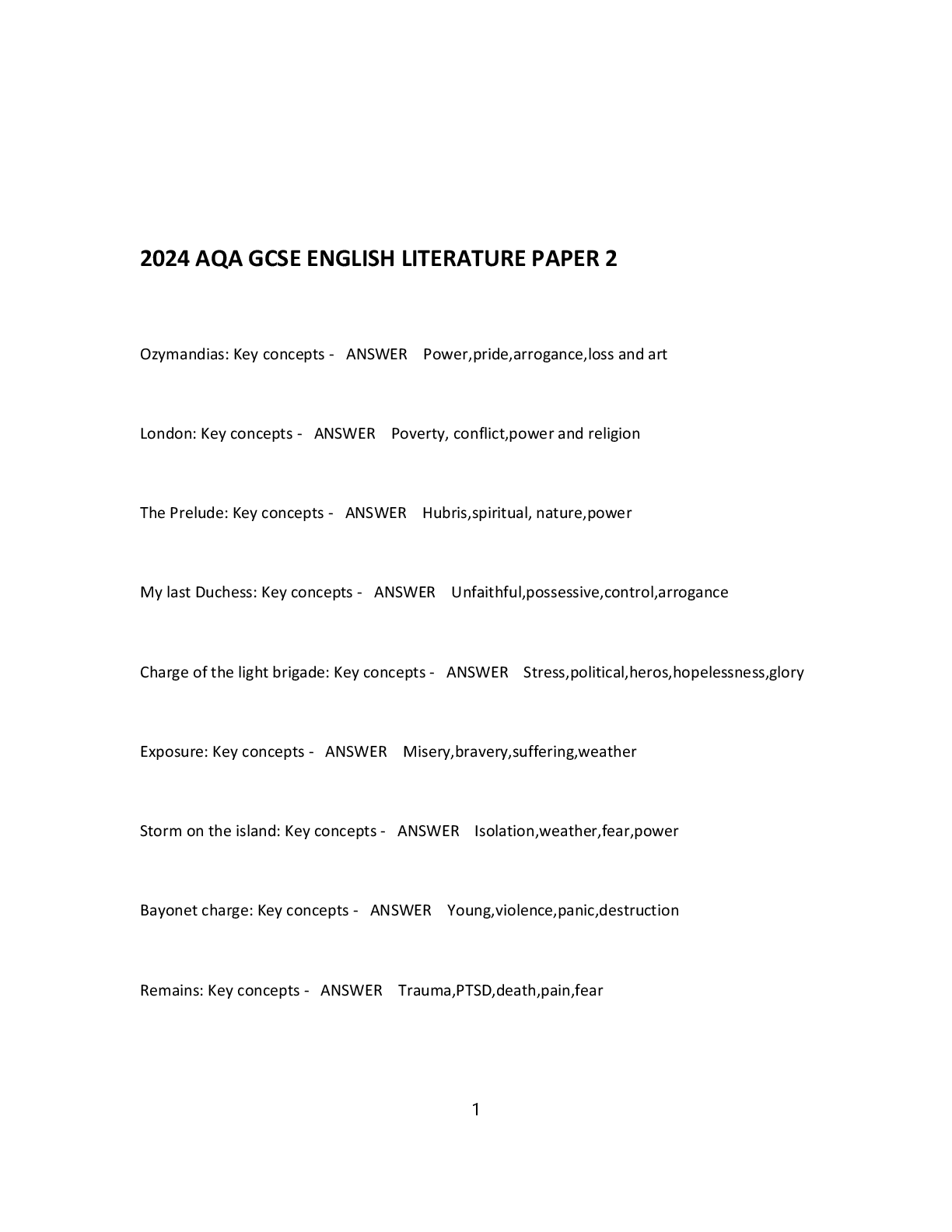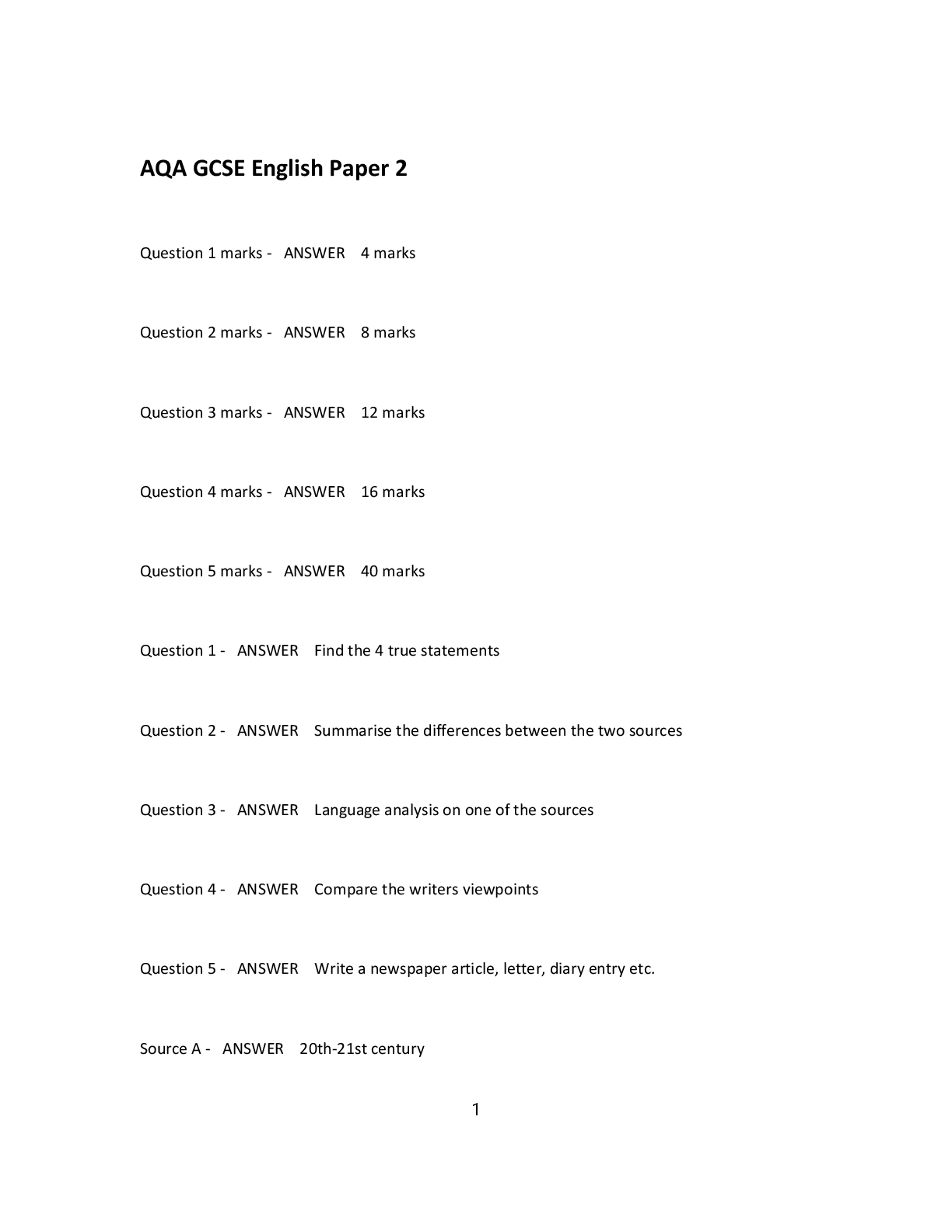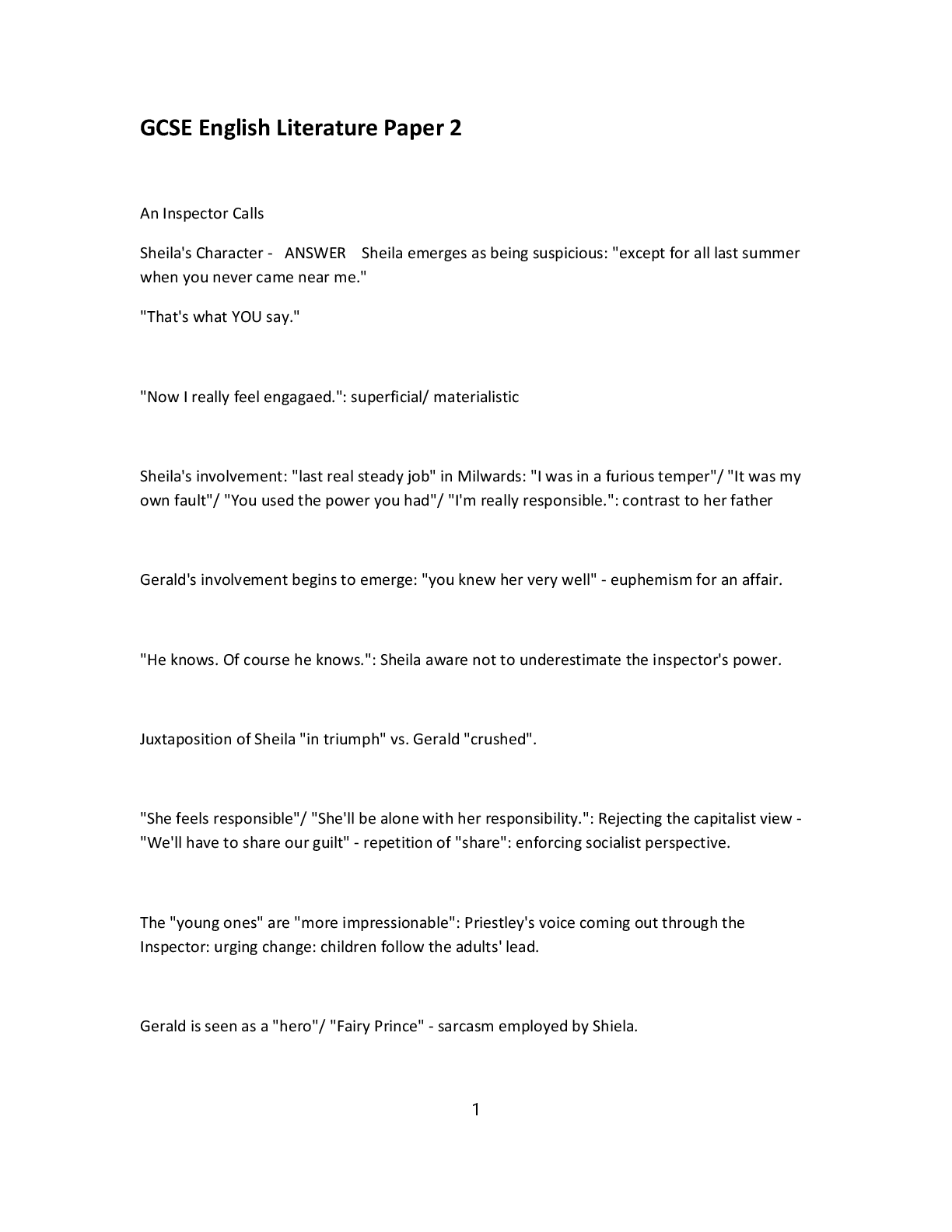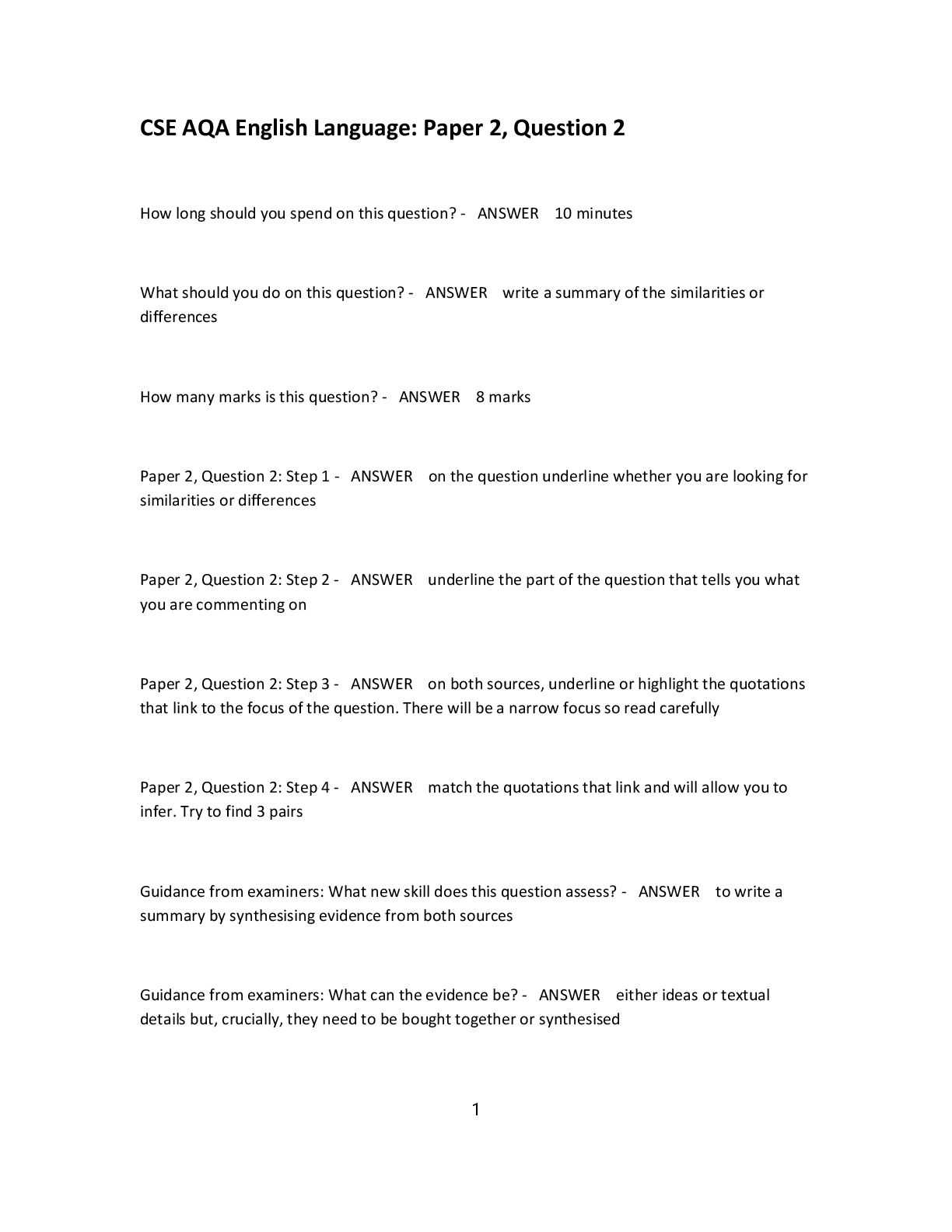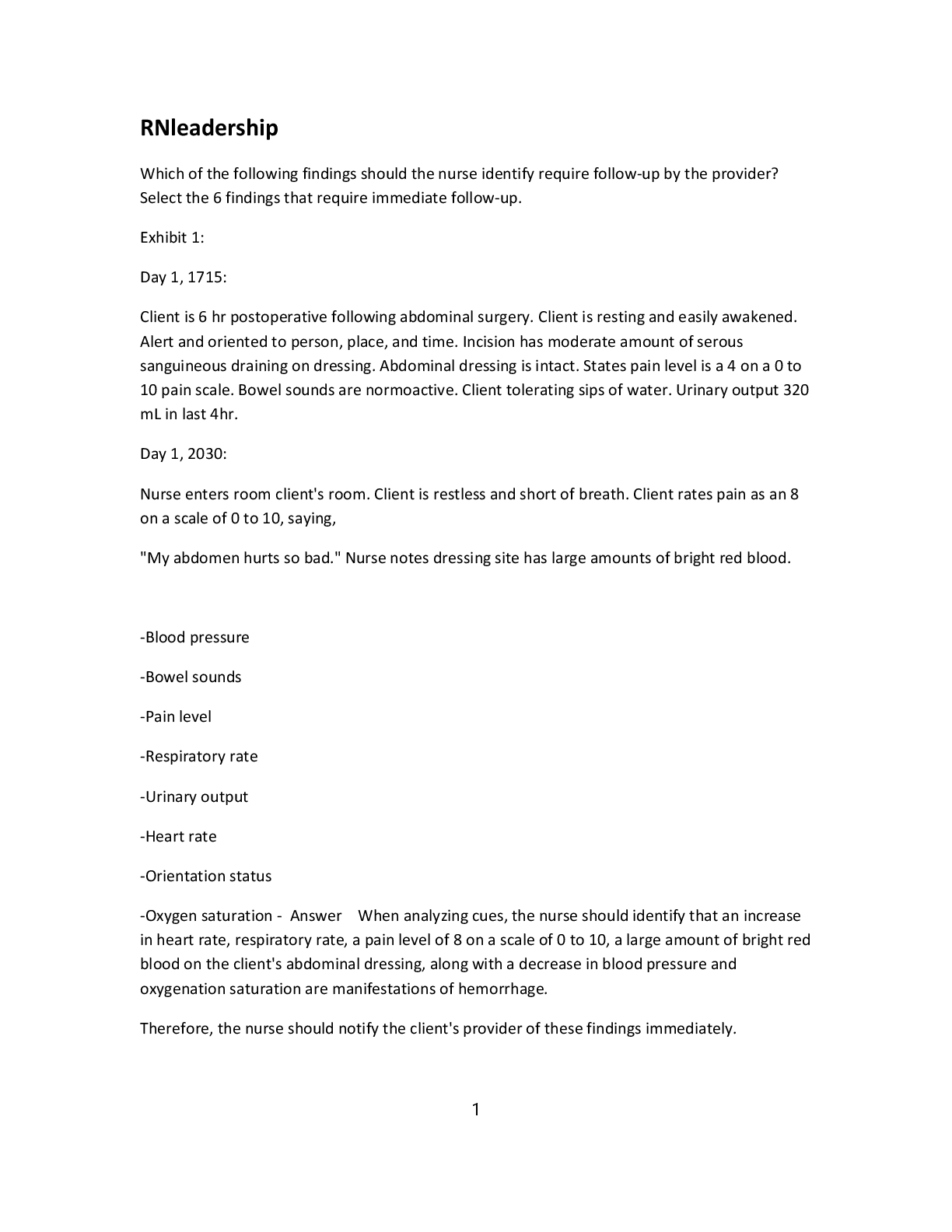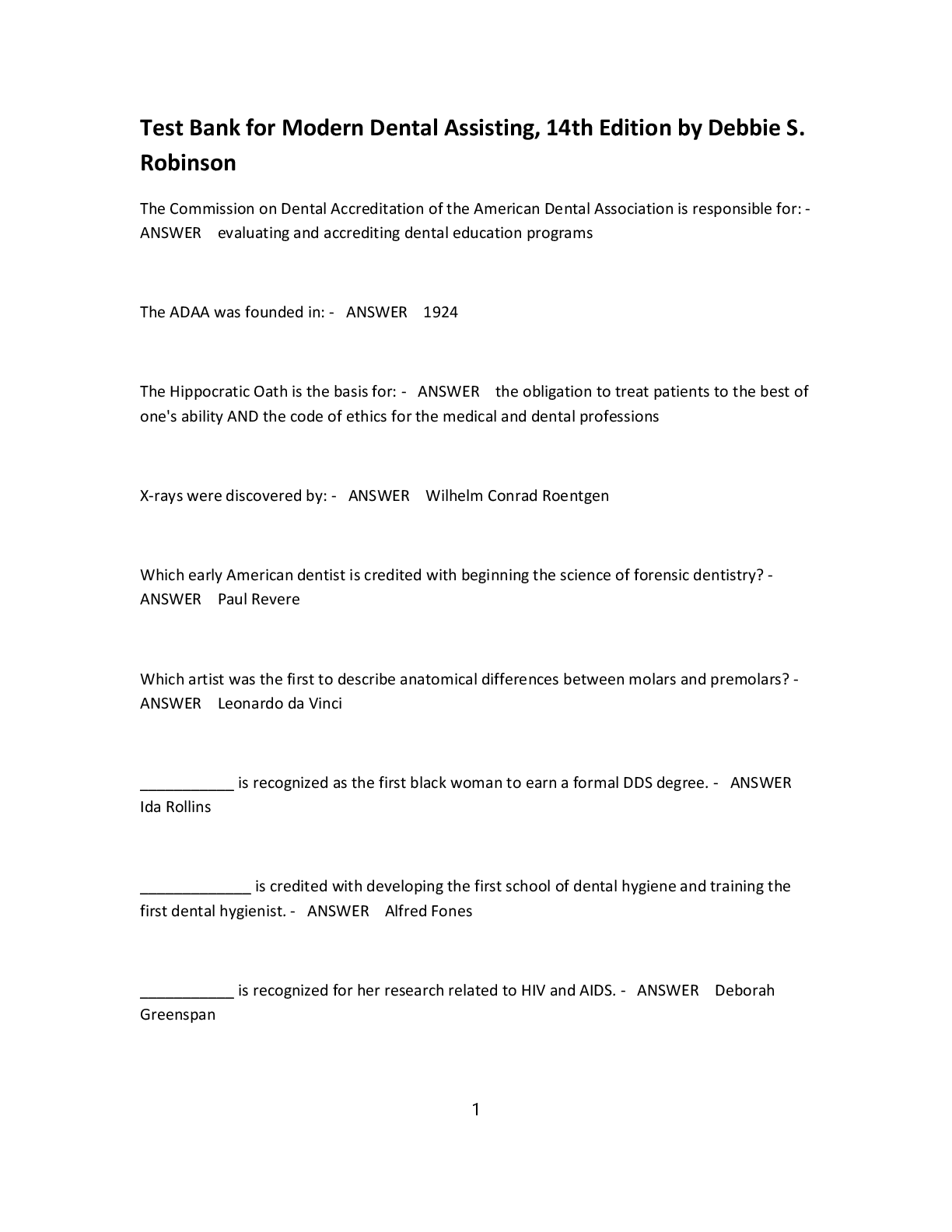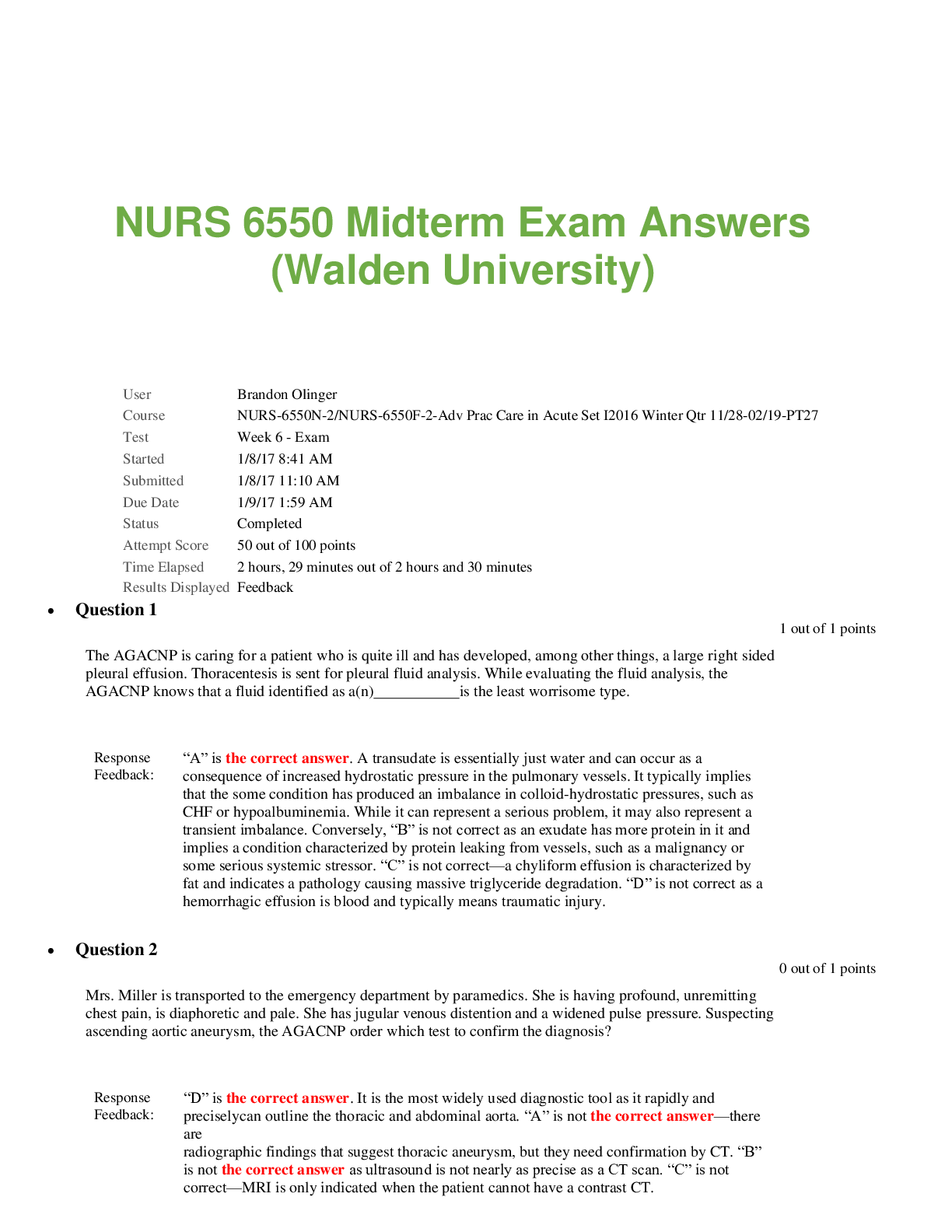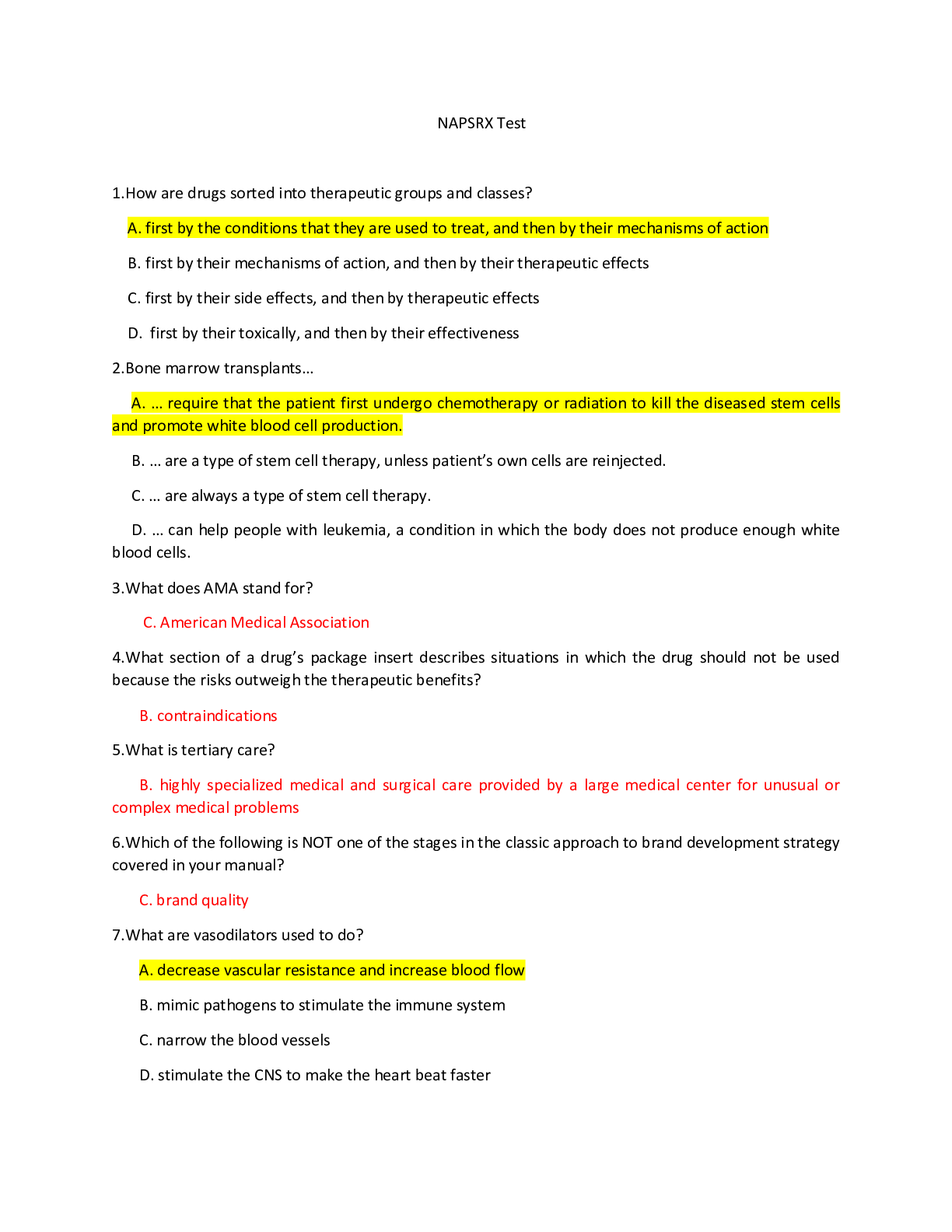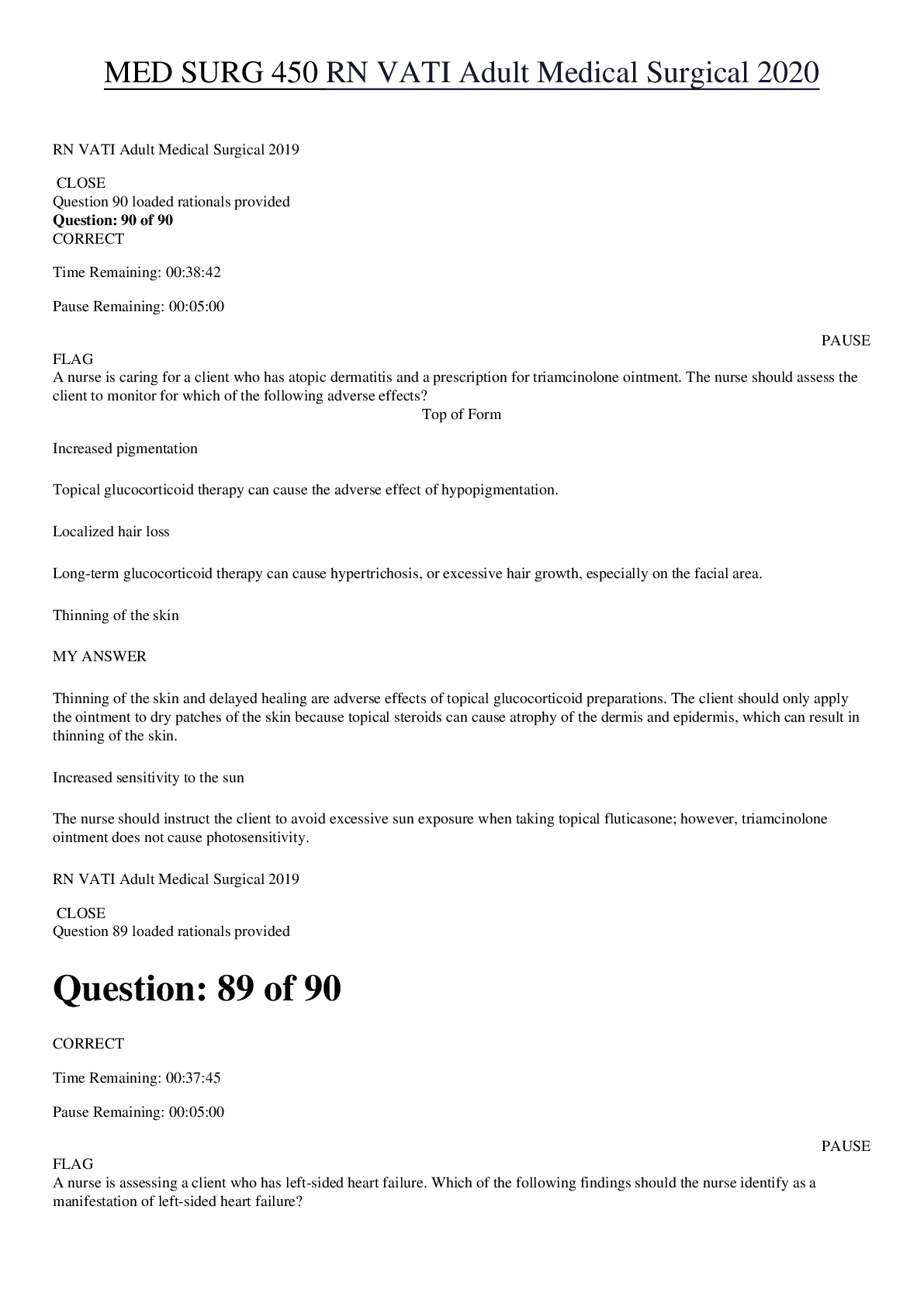ATI RN MED SURG PROCTORED EXAM 2023 LATEST EXAM > EXAM > ATI RN ADULT MEDICAL SURGICAL EXAM | Contains 90 Q&A Plus Rationale (All)
ATI RN ADULT MEDICAL SURGICAL EXAM | Contains 90 Q&A Plus Rationale
Document Content and Description Below
ATI RN ADULT MEDICAL SURGICAL EXAM | Contains 90 Q&A Plus Rationale A nurse is providing postoperative teaching for a client who had a total knee arthroplasty. Which of the following instructions sh... ould the nurse include? - ANSWER Flex the foot every hour when awake. Rationale: The nurse should instruct the client to flex the foot every hour to reduce the risk for thromboembolism and promote venous return. A nurse is caring for a client who has a pneumothorax and a closed-chest drainage system. Which of the following findings is an indication of lung re-expansion? - ANSWER Bubbling in the water seal chamber has ceased. Rationale: Bubbling in the water seal chamber ceases when the lung re-expands. A nurse is reviewing the medical record of a client who is taking warfarin for chronic atrial fibrillation. Which of the following values should the nurse identify as a desired outcome for this therapy? - ANSWER INR 2.5 Rationale: Clients receive warfarin therapy to decrease the risk of stroke, myocardial infarction (MI), or pulmonary emboli (PE) from blood clots. Since warfarin is an anticoagulant, the medication must be monitored to ensure the anticoagulation is within the therapeutic range and prevent hemorrhage (high levels of anticoagulation) or stroke, MI, or PE (low levels of anticoagulation). An INR of 2.5 is within the targeted therapeutic range of 2 to 3 for a client who has atrial fibrillation. A home health nurse is providing teaching to a client who has a stage 1 pressure injury on the greater trochanter of his left hip. Which of the following instructions should the nurse include in the teaching? - ANSWER Change position every hour Rationale: Changing position every 1 to 2 hr decreases pressure on bony prominences. The nurse should also instruct the client to limit the angle of the hips when in a lateral position to no more than 30°. This positioning prevents direct pressure on the trochanter. A nurse is assessing a client following the completion of hemodialysis. Which of the following findings is the nurse's priority to report to the provider? - ANSWER Restlessness Rationale: Using the urgent vs. nonurgent approach to client care, the nurse should determine that the priority finding to report to the provider is restlessness, which can be an indication the client is experiencing disequilibrium syndrome. Disequilibrium syndrome is caused by the rapid removal of electrolytes from the client's blood and can lead to dysrhythmias or seizures. Other manifestations include nausea, vomiting, fatigue, and headache. A nurse is caring for a client who is 8 hr postoperative following a total hip arthroplasty. The client is unable to void on the bedpan. Which of the following actions should the nurse take first? - ANSWER Scan the bladder with a portable ultrasound. Rationale: The first action the nurse should take using the nursing process is to assess the client. Scanning the bladder with a portable ultrasound device will determine the amount of urine in the bladder A nurse is planning a health promotional presentation for a group of African American clients at a community center. Which of the following disorders presents the greatest risk to this group of clients? - ANSWER Hypertension Rationale: When using the safety/risk reduction approach to client care, the nurse should determine that the disorder with the greatest risk for this group of clients is hypertension. The prevalence of hypertension is highest among African American clients, followed by Caucasian clients, and then Hispanic clients. A nurse is caring for a client who has DKA. Which of the following findings should indicate to the nurse that the client's condition is improving? - ANSWER Glucose 272 mg/dL Rationale: A glucose reading less than 300 mg/dL indicates improvement in the client's status. A nurse is caring for a client following extubation of an endotracheal tube 10 min. ago. Which of the following findings should the nurse report to the provider immediately? - ANSWER Stridor Rationale: Using the urgent vs. nonurgent approach to client care, the nurse should determine that the priority finding is stridor. Stridor can indicate a narrowing airway or possible obstruction caused by edema or laryngeal spasms. The nurse should report the finding immediately and implement an intervention. A nurse is caring for a client who had a nephrostomy tube inserted 112 hr ago. Which of the following findings should the nurse report to the provider? - ANSWER The client reports back pain Rationale: The nurse should notify the provider if the client reports back pain, which can indicate that the nephrostomy tube is dislodged or clogged. A nurse is admitting a client who has active TB. Which of the following types of transmission precautions should the nurse initiate? - ANSWER Airborne Rationale: Airborne precautions are required for clients who have infections due to micro-organisms that can remain suspended in air for lengthy periods of time, such as tuberculosis, measles, varicella, and disseminated varicella zoster. A nurse is planning care for a client who has a sealed radiation implant for cervical cancer. Which of the following interventions should the nurse include in the plan of care? - ANSWER Keep a lead-lined container in the client's room Rationale: The nurse should keep a lead-lined container and forceps in the client's room in case of accidental dislodgement of the implant. A nurse is assessing a client who is postoperative following a thyroidectomy. Which of the following findings is the nurse's priority? - ANSWER Temperature 38.9° C (102° F) Rationale: When using the urgent vs. nonurgent approach to client care, the nurse should determine that the priority finding is an elevated temperature. An elevated temperature is a manifestation of excessive thyroid hormone release, or thyroid storm, due to an increase in metabolic rate. The nurse should report this finding immediately to the provider because it can lead to seizures and coma. A nurse is providing discharge teaching about infection prevention to a client who has AIDS. Which of the following statements by the client indicates understanding of the teaching? - ANSWER "I will no longer floss my teeth after brushing my teeth." Rationale: The nurse should instruct the client to avoid flossing teeth to prevent gum inflammation, which could create the opportunity for infection. A nurse is providing teaching to a client who has hypertension and a new prescription for verapamil. Which of the following information should the nurse include in the teaching? - ANSWER "Increase fiber intake to avoid constipation." Rationale: The nurse should instruct the client that constipation is an adverse effect of verapamil. The client should increase fiber intake to promote regular bowel function. A nurse is providing education to a client who is at risk for osteoporosis. Which of the following instructions should the nurse include? - ANSWER Walk for 30 min four times per week. Rationale: Weight-bearing exercises promote bone mass. Therefore, walking can help the client prevent osteoporosis. A nurse is providing teaching to a client who is perimenopausal and has a prescription for hormone replacement therapy. For which of the following? - ANSWER Calf pain Numbness in the arm Intense headache Rationale: Calf pain is correct. Calf pain is an indication of deep-vein thrombosis. The client should report this finding to the provider immediately. Numbness in the arms is correct. Numbness in the arms can indicate a cerebrovascular accident, which is an adverse effect of hormone replacement therapy. The client should report this finding to the provider immediately [Show More]
Last updated: 4 months ago
Preview 5 out of 21 pages

Loading document previews ...
Buy this document to get the full access instantly
Instant Download Access after purchase
Buy NowInstant download
We Accept:

Reviews( 0 )
$17.00
Can't find what you want? Try our AI powered Search
Document information
Connected school, study & course
About the document
Uploaded On
Feb 11, 2025
Number of pages
21
Written in
Additional information
This document has been written for:
Uploaded
Feb 11, 2025
Downloads
0
Views
25

